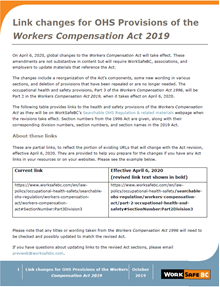- Home
- Law & Policy
- Occupational Health & Safety
- Searchable OHS Regulation & related materials
- Associated resources
- Overview of changes for WCA 2019
-
- Part 1 Scope of Act
- Part 2 Occupational Health and Safety
- Part 3 Workers' Compensation System
- Part 4 Compensation to Injured Workers and Their Dependants
- Part 5 Accident Fund and Employer Assessment
- Part 6 Review of Board Decisions
- Part 7 Appeals to Appeal Tribunal
- Part 8 Workers' Compensation Board and General Matters
- Schedules
-
- 1. Definitions
- 2. Application
- 3. Rights and Responsibilities
- 4. General Conditions
- 5. Chemical Agents and Biological Agents
- 6. Substance Specific Requirements
- 7. Noise, Vibration, Radiation and Temperature
- 8. Personal Protective Clothing and Equipment
- 9. Confined Spaces
- 10. De-energization and Lockout
- 11. Fall Protection
- 12. Tools, Machinery and Equipment
- 13. Ladders, Scaffolds and Temporary Work Platforms
- 14. Cranes and Hoists
- 15. Rigging
- 16. Mobile Equipment
- 17. Transportation of Workers
- 18. Traffic Control
- 19. Electrical Safety
- 20. Construction, Excavation and Demolition
- 21. Blasting Operations
- 22. Underground Workings
- 23. Oil and Gas
- 24. Diving, Fishing and Other Marine Operations
- 25. Camps
- 26. Forestry Operations and Similar Activities
- 27. Wood Products Manufacturing
- 28. Agriculture
- 29. Aircraft Operations
- 30. Laboratories
- 31. Firefighting
- 32. Evacuation and Rescue
- 34. Rope Access
-
- Policies for the Workers Compensation Act
- 2. Application
- 4. General Conditions
- 5. Chemical Agents and Biological Agents
- 8. Personal Protective Clothing and Equipment
- 10. De-energization and Lockout
- 17. Transportation of Workers
- 19. Electrical Safety
- 20. Construction, Excavation and Demolition
- 24. Diving, Fishing and Other Marine Operations
- 26. Forestry Operations and Similar Activities
- 30. Laboratories
-
- Guidelines for the Workers Compensation Act
- 1. Definitions
- 2. Application
- 3. Rights and Responsibilities
- 4. General Conditions
- 5. Chemical Agents and Biological Agents
- 6. Substance Specific Requirements
- 7. Noise, Vibration, Radiation and Temperature
- 8. Personal Protective Clothing and Equipment
- 9. Confined Spaces
- 10. De-energization and Lockout
- 11. Fall Protection
- 12. Tools, Machinery and Equipment
- 13. Ladders, Scaffolds and Temporary Work Platforms
- 14. Cranes and Hoists
- 15. Rigging
- 16. Mobile Equipment
- 17. Transportation of Workers
- 18. Traffic Control
- 19. Electrical Safety
- 20. Construction, Excavation and Demolition
- 21. Blasting Operations
- 22. Underground Workings
- 23. Oil and Gas
- 24. Diving, Fishing and Other Marine Operations
- 26. Forestry Operations and Similar Activities
- 28. Agriculture
- 29. Aircraft Operations
- 30. Laboratories
- 31. Firefighting
- 32. Evacuation and Rescue
- 34. Rope Access
- Updates
- My Handbook
Overview of changes for the Workers Compensation Act 2019
Changes to the language and numbering in the Workers Compensation Act came into effect on April 6, 2020. Learn more about these amendments.
These amendments are not substantive in content but require WorkSafeBC, associations, and employers to update materials that reference the Act. The changes include a reorganization of the Act's components, some new wording in various sections, and deletion of provisions that have been repealed or are no longer needed.
To assist you with this transition, this resource provides links to the health and safety provisions of the Workers Compensation Act on the Searchable OHS Regulation & related materials webpages. Section numbers from the 1996 Act are given, along with their corresponding division numbers, section numbers, and section names in the 2019 Act.
Resources
Link changes for OHS Provisions of the Workers Compensation Act 2019
Changes to the language and numbering in the Workers Compensation Act came into effect on April 6, 2020.
These amendments are not substantive in content but require WorkSafeBC, associations,...

